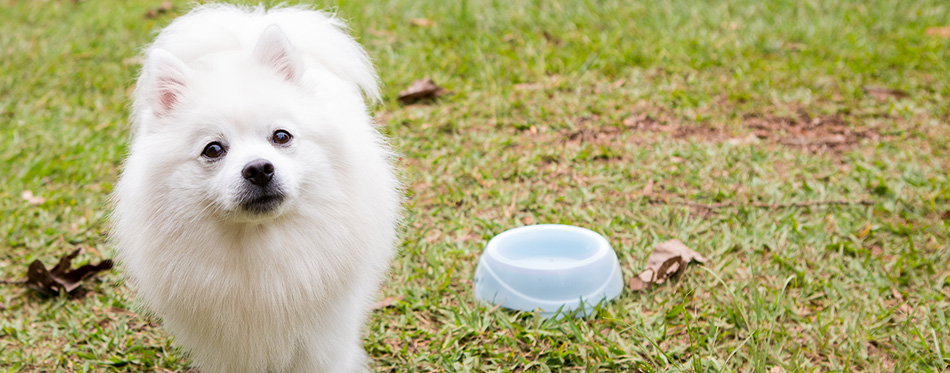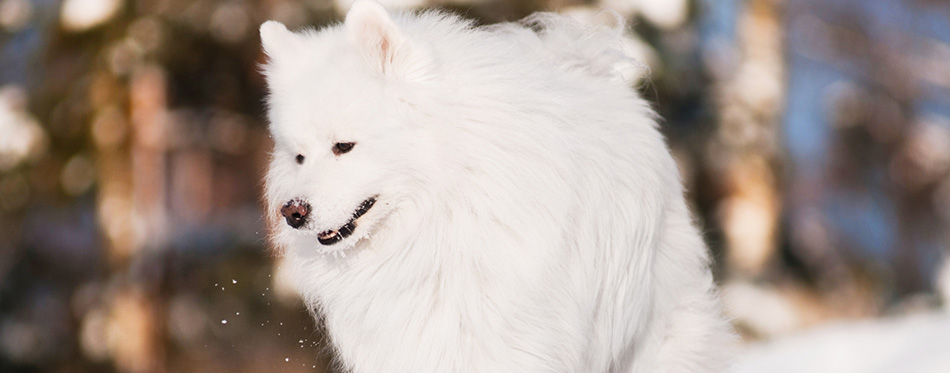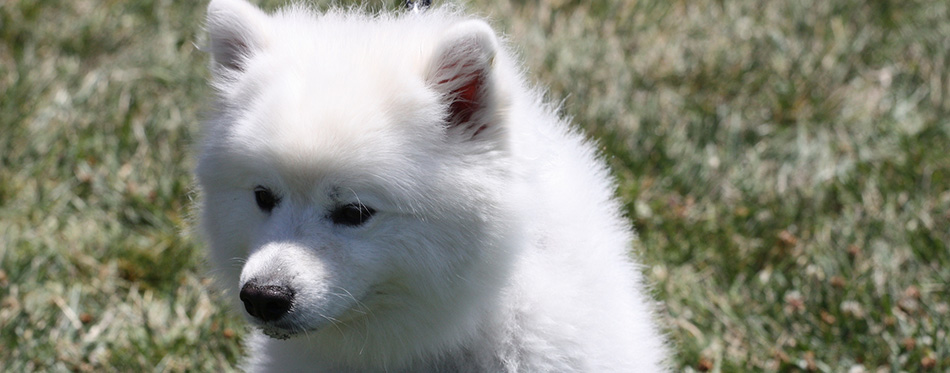With its luxuriously fluffy white coat, trainable attitude and sharp mind, the American Eskimo is a wonderful combination of brains and stunning good looks. Affectionately called the ‘Eskie’, this live-wire dog packs on the personality, making them friendly and oh so entertaining family pets. Available in three sizes – toy, miniature and standard – the Eskie can fit into most domestic lifestyles and is a loyal and loving, if not a tad strong-willed, companion.
Also known as the Alaskan Eskimo, we get the lowdown on the lovely American Eskimo and show you just why this cheeky chap could well be your ideal furry friend.

History of the American Eskimo Dog
Also known as the ‘Eskie’, the American Eskimo dog is a stunning breed revered for its friendly, upbeat nature and highly trainable attitude. The Eskie is a member of the Spitz breed, and is believed to have originated from the white German Spitz, which came to the US with European immigrants in the late 1800s. A Nordic breed, the Spitz are characterized by their fox-like faces, white fluffy fur, small, alert ears and a tail that curls over the back. Other Nordic breeds include the Pomeranian and the Samoyed and were originally bred to be watchdogs as well as farm dogs, thanks to their intelligence and loyal character.
The actual origins of the American or Alaskan Eskimo dog is not truly known but are believed to be descendants of the white German Spitz, along with the Pomeranian and the white Keeshonden which all came over with the European communities that settled in the US. They were originally known as the American Spitz or Eskimo Spitz, until 1917, when they were renamed the American Eskimo dog, thought to be as a result of the First World War and a move to distance the association with Germany (Spitz is a German term for Nordic dogs with pointed muzzles). The breed has no association with the Eskimo culture.
In 1985, the American Eskimo Dog Club of America was formed, and the breed was eventually recognized by the American Kennel Club in 1995.
Quick Facts About the American Eskimo
The average cost of an American Eskimo puppy is between $600-$1000, but for the top breed lines you can expect to pay in the region of $4000, so they are an investment in both money and time. But with their upbeat, lively nature, moderate exercise needs and super-trainable brain, the American Eskimo dog can make a fantastic family pet. We take a look at some fascinating facts about this gorgeous breed:
- They come in three sizes
The American Eskimo dog is certainly a versatile breed, and conveniently comes in three sizes – standard, toy and miniature American Eskimo – so there is a size that will fit in with most domestic set ups. The largest size the breed grows to is around 19 inches to the shoulder for male dogs while the smallest is around 9 inches for a female toy American Eskimo. A healthy weight for the American Eskimo is between 8-11 pounds (Toy) to up to 35-40 pounds for the standard breed.
- They have the most luxuriant coat
The dense, white coat is one of the distinct traits that make the American Eskimo such an appealing dog. The coat is actually double-furred, to create a cloud-like feel, which insulates the body from the cold. While most Eskies are a sparkling white, some also come with markings on the fur, which is described as a biscuit cream and these are the only two colors allowed for the breed. The fur distribution on the Eskie includes a lion-style ruff around the chest and shoulders as well as fluffy tail that curls over the dog’s back. And while the coat is thick, it is surprisingly straight without any waves and efficiently protects the body from frostbite and extremes of cold.
- They like to talk!
He may look soft and cuddly, but the American Eskimo dog is a very vocal chap and loves to let you know he is around. And, as a barker, he certainly has a lot to say, with a repertoire of barks, yelps, yowls and lower growls that almost makes him sound as if he can talk! His yap can be high pitched and while his talkative nature makes the American Eskimo an excellent watch dog, you do need to keep his vocalization in check otherwise he can become a bit of a problem barker, especially if left alone for periods at a time.
- They are protective
The American Eskimo is a loyal, brave breed that likes to let their presence be felt and are known to be protective of their special human. With his loud, shrill bark, he will certainly let you know who is around and his first instinct is to be suspicious of any strangers. But once they know it is a friend, not a foe, he will settle down and warm to visitors to your home.
- They were the star of the circus
With its intelligence and highly trainable attitude, the American Eskimo is a natural performer; so much so the breed was a hit in the circus in at the turn of the 20th Century.
The American Eskimo became a draw at the circus for its crowd-pleasing antics and ability to perform tricks as part of the ever-popular travelling circuses across the States. Taking center stage at the family friendly circus performances also served to boost the popularity of the breed.

Things You Should Know
Cute, lively and very bright, the American Eskimo make great companions, as well as a loveable pet for families with older children. Despite their super-fluffy double fur coat, the Eskie is relatively low maintenance, but as with all dogs, taking on a new American Eskimo puppy is still a commitment you need to prepare for.
To help you decide if the Eskie is the right pup to add to your family, we’ve put together the essential things you need to know about this adorable breed.
Health
The Eskie is a pretty long-living pooch, with an average life expectancy of around 14-16 years. As a hardy breed, they are overall healthy and are susceptible to only a few conditions although as with any animal, you need to be prepared. The main conditions your Eskie could be vulnerable to are:
- Hip dysplasia: an inherited condition, hip dysplasia is where the thighbone fails to fit properly into the hip joint and can lead to pain and mobility issues as well as arthritis as your pooch gets older. It is a genetic disease so if you are buying an American Eskimo puppy, ask the breeder for proof the parent dogs have both been screened for the condition.
- Legg-calve-perthes disease: this is another condition that affects the hip joint and is caused by a decreased blood supply to the head of the femur bone, which connects to the pelvis. Lack of blood can cause the hip joint to disintegrate and will show in pups around 4-6 months old, causing limping and reduced leg muscle – or atrophy. The good news is surgery can correct the damage caused but there is evidence that it can be a genetic condition so speak to your breeder about the parents of your new pup.
- Progressive retinal atrophy: eye problems can also affect the Eskie, and the prominent condition they can be susceptible to is progressive retinal atrophy where a dog’s eyesight gradually deteriorates due to damage to the retina. Early symptoms include night blindness and can result in limited vision or total sight loss.
- Juvenile cataracts: Young Eskies (less than six years old) can develop cataracts due to what is believed to be a hereditary condition. Always ask the breeder if your potential new pup has been tested for juvenile cataracts and ask to see the certificates to be sure.
- Other conditions: there are other health problems that can affect the American Eskimo include diabetes, allergies, hypothyroidism and dental issues. Always ensure you buy your Eskie pup from a reputable breeder, ask for details on theirs and the parents’ health history and, if you are concerned, consult your veterinary professional for more information on the breed.
Training
With the Eskie, you have a dog with a quick brain which is well-adapted to obedience training, hence the breed’s track record as very successful circus trick dogs. The breed is also known to excel in agility and other dog sports. However, there is a little downside to this bright spark’s intelligence and that is his tendency for free-thinking and stubbornness, especially when he thinks he is right! Patience and early obedience training can resolve these quirks, without dampening his independence. Effective training and early socialization will also instill manners and understanding of the pack, and who his pack leader is.
Motivation, patience and positive reinforcement are key to a happy, well-trained Eskie as well as problem-solving playtime as solving puzzles and trick learning is where this bright little spark really excels. Eskies also have impressive levels of stamina and desire to learn so prepare yourself for lifelong training, playtime and fun to keep him stimulated and happily occupied…as well as boredom at bay.
Exercise
An interesting aspect of the lively Eskie is that they only need a moderate amount of exercise, but it does need to be regular and he needs to active and able to move around when out on his daily walk. This makes him an ideal family pet or urban canine dweller, but he also needs to be stimulated and have plenty of chances to play when in the home. You need to be mindful when letting your American Eskimo Dog out in the garden or backyard as all that intelligence makes the Eskie an excellent escape artist if not properly – and safely – confined.
Nutrition
As a hardy breed, the American Eskimo Dog doesn’t have any special dietary requirements, although some Eskies can be sensitive to some dog food ingredients such as salmon so monitor their response if you change their normal dog food. To keep your Eskie healthy, opt for a high-quality dry dog food, with all the essential nutrients, vitamins and supplements they need, including Omega fatty acids to support their mobility. Also, watch their portion sizes and limit treats to prevent obesity.
For more guides on choosing the right dog food, you may wish to check out our reviews of the best dehydrated dog food, organic dog food, grain free dog food, wet dog food and puppy food.
Grooming
Yes, they do have a luxuriant, double-layered white coat but the Eskie is relatively easy to maintain when it comes to their grooming routine. They do shed continuously and will do a full coat ‘blow out’ twice a year, so are not the most ‘hypoallergenic’ pooch but with regular brushing, the fluff and fur around the home issue can be contained. It’s recommended that the American Eskimo Dog is brushed at least three times a week to prevent the long fur from matting and to clean away loose hair. And when it comes to bathing, it should be done every few months maximum otherwise their skin can become irritated. While grooming, check their nails and get them clipped if necessary and also check their ears and eyes and gently clean as needed.
Check out our dog grooming guides: Dog wipes, dog shampoo, medicated dog shampoo, dog paw washer, dog grooming gloves, dog shedding brush, dog ear cleaner and dog nail clippers.

Temperament
Friendly, funny, intelligent and lively but also very loyal, the American Eskimo Dog is a joy to have around. But as with any breed, the Eskie does have its behavior quirks. First up, they are prone to excessive barking, especially if left alone for longer periods of time and early socialization is a good idea so they can stop being so suspicious of new people coming into your home. But as their personality is so sweet, Eskies can quickly learn to welcome and accept strangers onto their home turf.
Eskies also thrive on company and this means they can become very devoted to their special humans, which makes them wonderful companion dogs as well as family pets. However, the downside to this devotion is that the American Eskimo Dog can be prone to separation anxiety if left alone too long. With a few adaptations and a consistent routine, all of these ‘quirks’ can be managed, leaving a fantastically friendly, loving and intelligent dog that will give you years of affection, entertainment, and fun. And with the Eskie, one thing is for sure, this loving dog really does want to please and make you happy!
Sources:
- American Eskimo Dog – AKC
- History of the American Eskimo Dog – AEDCA

